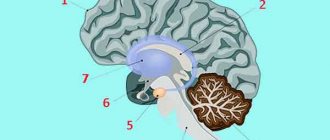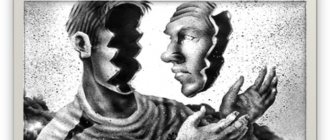Ivan Bunin has a poem that has become an absolute classic.
And bumblebees, and flowers, and grass, and ears of corn,
And the azure, and the midday heat. The time will come. The Lord will ask the prodigal son: “Were you happy in your earthly life?”
And I'll forget about everything. I will only remember these Field paths between the ears and grasses. And from the blissful tears I will not be able to answer, falling to the merciful knees.
Any symboldrama session begins, as we already wrote in the previous article, with the presentation of the image of a meadow.
The meadow is a “maternal” symbol that reveals the first year of a person’s life, as it remains in his unconscious memory.
At the superficial level of self-absorption, the meadow expresses only the general background of the momentary mood, the current situation. However, remember: the deeper meaning of the meadow will always “seep through” the superficial “photograph” of the mood. Thus, the meadow imagined in the mind is always both, in an unknown proportion.
“Psychological norm” for the image of a meadow
When a person is “normal”, he visualizes a picture with the following characteristics:
- the picture is flooded with bright sunlight, the weather is good, there is sun in the sky.
- an abundance of herbs and flowers, rich juicy greens
- time of day: afternoon or morning
- time of year: summer or late spring
As a matter of fact, we should ultimately arrive at such a visualization. However, it would be a mistake to immediately visualize “how it’s correct.” You must visualize exactly what you want at the moment.
Deviations from the norm in the image of a meadow
A gray, cloudy sky, a beginning storm, a winter landscape, early spring, late autumn... almost all of this indicates depression, increased anxiety, well-built mechanisms of neurotic defense from the outside world (winter landscape).
It’s very interesting what, besides the meadow, you can imagine. The norm is to see a meadow bounded by a natural landscape - a copse, a grove, a well-groomed field, a river, etc.
Endless meadows across the entire width of the imagination are illusions about one’s future, failure to imagine oneself in the world, “childishness” of perception.
On the contrary, a meadow that has turned into a miserable clearing, compressed on all sides by a dark forest, is a sign of tightness, complexes, and a depressed depressive state.
However, all of the above is still only a diagnosis of the condition. Although a psychotherapeutic effect can be obtained by simply throwing out these emotions and sketching them later at will, it doesn’t matter: at the diagnostic stage you can’t expect miracles yet. Miracles begin when you start working with a picture of a meadow, acting in its space, encountering obstacles and somehow resolving them.
Working in the visualization space means that you “allow” yourself to do what you want in the meadow. If it doesn’t occur to you what to do in the meadow and nothing brings you joy, then this indicates your basic life attitude. It means passivity, waiting for orders and instructions from other people, “from above,” and lack of the habit of following one’s own desires and impulses.
Having entered a state of deep visualization, you must work with the thoughts that arise in you while exploring your “fantastic” world. Everything you do there with symbols will make your life easier “here” with people and situations. If you kill the dragon there, the problems here will resolve. The classics of symbol drama give the following example: a girl was admitted to an appointment who was experiencing psychological difficulties due to the fact that she had an ugly wart on her finger. At the very first session, the analyst asked her to imagine a meadow, and then immediately moved on to the motif of a stream. The girl very vividly imagined a meadow, and immediately ran to the stream and dipped her hands into it. The analyst asked the girl to “leave her hands in the water” and describe her sensations. The girl said that her wart had dried up. And three days later, the girl’s wart really dried out and fell off! She conducted psychotherapy for herself, ahead of the therapist’s questions and instructions!
That’s why, when practitioners say that a course of symboldrama can cure not only enuresis, stuttering and phobias, but also acne and warts, they are not joking or exaggerating, everything is exactly as it is.
After you feel your Meadow well and deal with everything that is on it, make it habitable, you can begin to visualize other basic motives. We will talk about them in our next articles.
Using the symboldrama method in the treatment of neurosis
Obsessive-compulsive neurosis. Obsessions are understood as thoughts alien to the self that arise against the will of the individual. Options for obsession are “mental chewing gum” and “hatching.” “Mental chewing gum” includes obsessive thinking, reflection, talking, thinking. Thus, obsessive patients may be prone to vague, repetitive thoughts. “Hatching” in its proper sense means sitting on eggs, covering them, as a bird does, respectively, “hatching” means constant, silent and at the same time anxious thinking about some problem. All of these mental phenomena involve an attempt to resolve an emotional conflict through reflection, but the individual avoids a solution or conclusion, and the process is repeated again and again. A person suffering from such a neurosis, as a rule, knows that his actions and thoughts are inappropriate, but cannot do anything about it. Symptoms of neurosis typically arise against the background of an obsessive nature.
The main conflicts in obsessive-compulsive neurosis and character type involve anxiety and guilt emanating from the superego. The first objects of the Super-Ego for a person are usually parents or figures replacing them, that is, the primary image of the Super-Ego is formed very early, at a stage when the child is not yet able to think or act independently - and when primary needs are not satisfied with one of their forms satisfaction becomes a retreat into fantasy. Later, at subsequent stages of development, protection from unacceptable fantasies arises, fantasies and conflicts are formed, for example, the negative Oedipus complex, which the Super-Ego does not allow to the level of consciousness and the individual regresses to an earlier anal-sadistic level from the point of view of psychoanalysis, which only increases feelings of guilt and internal conflict.
To work through these conflicts, it is necessary to work through the earliest stages of the formation of the Ego and Super-Ego - one of the effective ways to work through is the method of symboldrama (catathymic-imaginative psychotherapy or catathymic experience of images), which allows you to work through the main conflict at the symbolic level.
The following example demonstrates the effective use of individual psychotherapy using this method for a patient suffering from obsessive-compulsive neurosis.
Patient S., 34 years old. Complains of constantly spontaneously arising uncontrollable anxious thoughts about a specific event or anxious expectations and fears associated with any events; obsessive, anxious thinking about past events, insomnia; increased blood pressure in cases of anxiety or stressful situations. At the start of psychotherapy, the patient had been in this state for six months, with periods of deterioration and improvement. The patient is married and has a daughter.
Psychotherapy lasted 6 months, with a frequency of sessions for 2 months 2 times a week, then once a week and a break due to the vacation period. A total of 34 sessions were held during this time. The following motifs were used in the work: “Flower”, “Meadow”, “Stream”, “Mountain”, “House”, “Cow”, “Elephant”, “Edge of the Forest”, “Plot of Land”, “Building a House”, “ The Hero’s Path”, the associative method was used.
At the first session, a test of the “ Flower ” motif was carried out. The patient presented a yellow tulip. A flower with a strong stem, two wide leaves and an open bud. The flower is cut off (displacement of the internal connection with the mother into the unconscious).
In the “Meadow” , I imagined a meadow, like when I was a child in the village with my grandparents. Summer, day, sunny. I imagined myself as a twelve-year-old boy (“regression for the sake of progression”). In a T-shirt and shorts, sneakers on his feet. In the meadow there is tall, bright green grass, many different flowers. There was a desire to lie on the grass (the need to satisfy archaic narcissistic needs), then run around the clearing, and then go to the village. I felt warmth and calm.
Stream ” (upstream) was proposed Yourself at the age of 25-27 years old in a T-shirt, summer pants, and light shoes. Summer, midday, nice sunny weather. The stream flows in a ravine, the banks are grassy, the bottom of the stream is sandy. I calmly reached the source. The source appeared in the form of a small spring gushing out of the ground. I washed my face, drank the water with pleasure (“Real spring water”), and filled a small bottle with water (the need to satisfy archaic oral needs). I felt freshness, coolness and cleanliness.
At the ninth session, the motif “ Stream” (downstream) was again proposed: the same place was presented - a clearing, a ravine, a stream. The patient imagined himself at the age of thirty. Went downstream. And suddenly I discovered some dark place, a hole, a stream goes underground and a swamp forms, and nearby there is a lake. The water in the lake is dirty, with some stains (frustration of oral needs). Tension, irritation. I wanted to fill up the hole and change the bed of the stream. Afterwards I felt new strength. The water in the lake changed, became cleaner, the dirt remained in the corners, I wanted to swim in the lake. In the discussion, I paid attention to the feelings in the image and connected them with disturbing thoughts in my life.
At the next meeting, a continuation of the "Stream" motif was proposed . The patient presented the same location. A stream, a new channel, a lake, the weather was warm, I wanted to go fishing. The mood is calm. I wanted to look at the place where the hole was. The place is overgrown with young grass. I wanted to go around the lake and imagined a small river flowing out of the lake, about 5 meters wide. The water in the river is clean, the current is fast. The river is expanding rapidly. When asked to board a boat without oars, he reacted calmly. I felt calm in the boat and watched the river with interest. The river gradually widens, about 50 meters. And turns into the sea. I felt calm and thoughtful. He said the following phrase, looking at the sea: “What was, what will be!”
Next, the “Mountain” motif was proposed . The patient imagined a mighty mountain covered with vegetation. I climbed the mountain along the serpentine easily, without effort. At the top ahead I saw a green valley with settlements in the distance. To the right and left are mountains and forest. There are hills behind. At the top I experienced a feeling of delight, admiration and a little grandeur. Without stopping for long, he descended with ease. Looking back, I saw how the mountain became smaller and lost its power. (Climbing uphill helps to increase self-esteem and level of aspirations, overcome depressive tendencies, and thereby strengthen the immune system thanks to “faith in the future”).
I would like to note that at the first stage, at the symbolic level, resource supply and satisfaction of archaic needs occurred. A pronounced age regression was observed in the patient's images, and relative satisfaction of narcissistic omnipotence was achieved. In addition, already in the first images the patient’s main conflict related to the relationship with his mother was reactivated.
At the 15th session S. was asked to present the motive “ Home ”. (The house is experienced primarily as an expression of one’s own personality or one of its parts. The house motif expresses the structures into which the patient projects himself and his desires, addictions, defensive attitudes and fears. These symbolized mental components relate to those emotionally experienced at the moment self-assessments.) The patient imagined the house and grandparents of their childhood. Describing the situation in the house, I felt warmth, calmness, and boredom. Going up to the attic, I felt disgusted by the dust and dirt. I wanted to quickly go down and wash my hands. Conflict points clearly emerged in the discussion: “I go into the house with interest, but it’s boring there.” Associations with the attic made it possible to clarify the conflict: these are negative thoughts associated with the expectation of bad things and the desire to escape from them. (To wash hands).
In the analytical work, the patient gradually began to turn to the events of his childhood; a trend emerged of age-related inconsistency in his attitude towards his mother - from love and the desire to meet her demands in early childhood, misunderstanding and deeply hidden resentment in the prepubertal and puberty period to open rejection and expression of aggression at the beginning of his own life. family life. In order to work through the deep feelings associated with this topic, the patient was offered the motif “ Cow ”. In the image I imagined a brown and white cow in a meadow. He went up to her and fed her grass. I stroked it and listened to my heart. And then he noticed her sad eyes. Looking into his eyes more carefully, he remembered himself at the age of 11-12 years old and his mother, who suddenly showed disobedience and strongly scolded him. I remembered a situation from childhood and worked it into the image. I asked my mother for forgiveness. Then, returning to the foreground, I noticed the cow’s eyes had changed, they became gentle and calm.
The drawing and further analytical work revealed a strong ambivalence towards the maternal figure. Thus, the patient interpreted the cow as a symbol of protection from the outside world, support, foundation, confidence. The figure of a patient appeared in the drawing. During the discussion at the next session, the patient expressed his reluctance to draw the grass as carefully as before.
To clarify the situation of triangulatory relations, the image “ Elephant ” was proposed. In the image, the patient imagined himself at first 15-16 years old in a meadow; when interacting with an elephant, the patient regressed to 10 years old. I imagined a not very large elephant, between an elephant and a baby elephant. A clean, sleek, kind and playful baby elephant. I walked with him in the clearing, played and felt joy. Then there was some anxiety, confusion from thoughts of what to do with him, but then he imagined that he had locked him in a pen near his grandparents’ house (the need to satisfy archaic oedipal needs). At the end I said goodbye to him and went home.
As a result of the therapeutic interaction, the patient began to allow himself more to articulate his emotional states (they gradually became more understandable to him), to express his emotions.
For the purpose of positive development of the functions of the mature self, the patient was offered the motif “Allotment of land.” He presented a large, 500x200 m apple orchard in Bashkiria, neat and well-groomed. The land is clean, without weeds. I felt warmth and calm.
The most significant motive of the symboldrama for the patient was the “Building a house” motive. The patient actively accepted the symbolic meaning of this motif, and in working with it a pronounced tendency towards greater maturity and structure was evident. After completing the presentation of the “Building a House” motif, the patient’s manifestations of apathy finally disappeared, he began to experience the joy of life, the background of his mood became stably stable, and his faith in a happy future strengthened.
The presented case well illustrates both the diagnostic and therapeutic possibilities of using symboldrama in the treatment of obsessive-compulsive neurosis. Feelings and emotions associated with the details of the images became the basis of depth psychological analysis and made it possible to carry out therapeutic intervention, having visual guidelines for the focus of psychotherapy.
Literature
- 1. Kutter P. Modern psychoanalysis. Introduction to the psychology of unconscious processes. St. Petersburg, 1997.
- 2. Leiner H. Catathymic experience of images. - M.: Eidos, 1996. - 253 pp..
- 3. Obukhov Ya.L. Review of Donald Woods Winnicott's concept of child development // https://www.symboldrama.ru.
- 4. Ronald Comer. Fundamentals of pathopsychology. — VOOKAR: Library of Psychological Literature //https:// bookap.info







